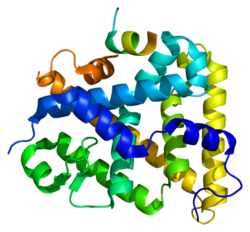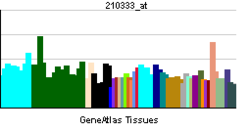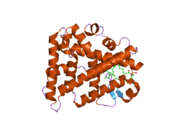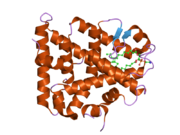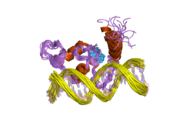- Steroidogenic factor 1
-
The steroidogenic factor 1 (SF1) protein controls sexual development in the embryo and at puberty.
SF1 is a member of the nuclear receptor family of intracellular transcription factors and is encoded by the NR5A1 gene (nuclear receptor subfamily 5, group A, member 1).[1]
Contents
Function
SF-1 is a critical regulator of reproduction, regulating the transcription of key genes involved in sexual development and reproduction. Its targets include genes at every level of the hypothalamic-pituitary-gonadal axis, as well as many genes involved in gonadal and adrenal steroidogenesis.[2]
Clinical significance
Mutations in NR5A1 can produce intersex genitals, absence of puberty, and infertility. It is one cause of arrest of ovarian function in women <40 years of age, which occurs in 1% of all women.
Missense, in-frame and frameshift mutations of NR5A1 have been found in families with 46,XY disorders of sex development, 46,XX gonadal dysgenesis and 46,XX primary ovarian insufficiency. 46,XY individuals may have ambiguous or female genitals. Individuals of either karyotype may not enter puberty, although expression of the phenotype, penetrance, fertility, and modes of inheritance can vary. Some mutations are dominant, some are recessive.[3]
Interactions
Steroidogenic factor 1 has been shown to interact with:
References
- ^ Taketo M, Parker KL, Howard TA, Tsukiyama T, Wong M, Niwa O, Morton CC, Miron PM, Seldin MF (1995). "Homologs of Drosophila Fushi-Tarazu factor 1 map to mouse chromosome 2 and human chromosome 9q33.". Genomics 25 (2): 565–7. doi:10.1016/0888-7543(95)80059-U. PMID 7789992.
- ^ Jameson JL (2004). "Of mice and men: The tale of steroidogenic factor-1.". J. Clin. Endocrinol. Metab. 89 (12): 5927–9. doi:10.1210/jc.2004-2047. PMID 15579738.
- ^ Lourenço D, Brauner R, Lin L, De Perdigo A, Weryha G, Muresan M, Boudjenah R, Guerra-Junior G, Maciel-Guerra AT, Achermann JC, McElreavey K, Bashamboo A (March 2009). "Mutations in NR5A1 associated with ovarian insufficiency". N. Engl. J. Med. 360 (12): 1200–10. doi:10.1056/NEJMoa0806228. PMC 2778147. PMID 19246354. http://www.pubmedcentral.nih.gov/articlerender.fcgi?tool=pmcentrez&artid=2778147.
- ^ Kennell JA, O'Leary EE, Gummow BM, Hammer GD, MacDougald OA (August 2003). "T-cell factor 4N (TCF-4N), a novel isoform of mouse TCF-4, synergizes with beta-catenin to coactivate C/EBPalpha and steroidogenic factor 1 transcription factors". Mol. Cell. Biol. 23 (15): 5366–75. doi:10.1128/MCB.23.15.5366-5375.2003. PMC 165725. PMID 12861022. http://www.pubmedcentral.nih.gov/articlerender.fcgi?tool=pmcentrez&artid=165725.
- ^ Mizusaki H, Kawabe K, Mukai T, Ariyoshi E, Kasahara M, Yoshioka H, Swain A, Morohashi K (April 2003). "Dax-1 (dosage-sensitive sex reversal-adrenal hypoplasia congenita critical region on the X chromosome, gene 1) gene transcription is regulated by wnt4 in the female developing gonad". Mol. Endocrinol. 17 (4): 507–19. doi:10.1210/me.2002-0362. PMID 12554773.
- ^ Lopez D, Shea-Eaton W, Sanchez MD, McLean MP (December 2001). "DAX-1 represses the high-density lipoprotein receptor through interaction with positive regulators sterol regulatory element-binding protein-1a and steroidogenic factor-1". Endocrinology 142 (12): 5097–106. doi:10.1210/en.142.12.5097. PMID 11713202.
- ^ Sugawara T, Saito M, Fujimoto S (August 2000). "Sp1 and SF-1 interact and cooperate in the regulation of human steroidogenic acute regulatory protein gene expression". Endocrinology 141 (8): 2895–903. doi:10.1210/en.141.8.2895. PMID 10919277.
- ^ Mellgren G, Børud B, Hoang T, Yri OE, Fladeby C, Lien EA, Lund J (May 2003). "Characterization of receptor-interacting protein RIP140 in the regulation of SF-1 responsive target genes". Mol. Cell. Endocrinol. 203 (1-2): 91–103. doi:10.1016/S0303-7207(03)00097-2. PMID 12782406.
- ^ Sugawara T, Abe S, Sakuragi N, Fujimoto Y, Nomura E, Fujieda K, Saito M, Fujimoto S (August 2001). "RIP 140 modulates transcription of the steroidogenic acute regulatory protein gene through interactions with both SF-1 and DAX-1". Endocrinology 142 (8): 3570–7. doi:10.1210/en.142.8.3570. PMID 11459805.
- ^ De Santa Barbara P, Bonneaud N, Boizet B, Desclozeaux M, Moniot B, Sudbeck P, Scherer G, Poulat F, Berta P (November 1998). "Direct interaction of SRY-related protein SOX9 and steroidogenic factor 1 regulates transcription of the human anti-Müllerian hormone gene". Mol. Cell. Biol. 18 (11): 6653–65. PMC 109250. PMID 9774680. http://www.pubmedcentral.nih.gov/articlerender.fcgi?tool=pmcentrez&artid=109250.
- ^ Gizard F, Lavallee B, DeWitte F, Teissier E, Staels B, Hum DW (October 2002). "The transcriptional regulating protein of 132 kDa (TReP-132) enhances P450scc gene transcription through interaction with steroidogenic factor-1 in human adrenal cells". J. Biol. Chem. 277 (42): 39144–55. doi:10.1074/jbc.M205786200. PMID 12101186.
Further reading
- Morohashi KI, Omura T (1997). "Ad4BP/SF-1, a transcription factor essential for the transcription of steroidogenic cytochrome P450 genes and for the establishment of the reproductive function.". FASEB J. 10 (14): 1569–77. PMID 9002548.
- Parker KL, Schimmer BP (1997). "Steroidogenic factor 1: a key determinant of endocrine development and function.". Endocr. Rev. 18 (3): 361–77. doi:10.1210/er.18.3.361. PMID 9183568.
- Achermann JC, Meeks JJ, Jameson JL (2003). "Phenotypic spectrum of mutations in DAX-1 and SF-1.". Mol. Cell. Endocrinol. 185 (1-2): 17–25. doi:10.1016/S0303-7207(01)00619-0. PMID 11738790.
- Ozisik G, Achermann JC, Jameson JL (2003). "The role of SF1 in adrenal and reproductive function: insight from naturally occurring mutations in humans.". Mol. Genet. Metab. 76 (2): 85–91. doi:10.1016/S1096-7192(02)00032-X. PMID 12083805.
- Jameson JL (2005). "Of mice and men: The tale of steroidogenic factor-1.". J. Clin. Endocrinol. Metab. 89 (12): 5927–9. doi:10.1210/jc.2004-2047. PMID 15579738.
- de-Souza BF, Lin L, Achermann JC (2006). "Steroidogenic factor-1 (SF-1) and its relevance to pediatric endocrinology.". Pediatric endocrinology reviews : PER 3 (4): 359–64. doi:10.1159/000094108. PMID 16816804.
- Sadovsky Y, Crawford PA, Woodson KG, et al. (1995). "Mice deficient in the orphan receptor steroidogenic factor 1 lack adrenal glands and gonads but express P450 side-chain-cleavage enzyme in the placenta and have normal embryonic serum levels of corticosteroids.". Proc. Natl. Acad. Sci. U.S.A. 92 (24): 10939–43. doi:10.1073/pnas.92.24.10939. PMC 40546. PMID 7479914. http://www.pubmedcentral.nih.gov/articlerender.fcgi?tool=pmcentrez&artid=40546.
- Sasano H, Shizawa S, Suzuki T, et al. (1995). "Ad4BP in the human adrenal cortex and its disorders.". J. Clin. Endocrinol. Metab. 80 (8): 2378–80. doi:10.1210/jc.80.8.2378. PMID 7629233.
- Shen WH, Moore CC, Ikeda Y, et al. (1994). "Nuclear receptor steroidogenic factor 1 regulates the müllerian inhibiting substance gene: a link to the sex determination cascade.". Cell 77 (5): 651–61. doi:10.1016/0092-8674(94)90050-7. PMID 8205615.
- Oba K, Yanase T, Nomura M, et al. (1996). "Structural characterization of human Ad4bp (SF-1) gene.". Biochem. Biophys. Res. Commun. 226 (1): 261–7. doi:10.1006/bbrc.1996.1343. PMID 8806624.
- Asa SL, Bamberger AM, Cao B, et al. (1996). "The transcription activator steroidogenic factor-1 is preferentially expressed in the human pituitary gonadotroph.". J. Clin. Endocrinol. Metab. 81 (6): 2165–70. doi:10.1210/jc.81.6.2165. PMID 8964846.
- Bamberger AM, Ezzat S, Cao B, et al. (1997). "Expression of steroidogenic factor-1 (SF-1) mRNA and protein in the human placenta.". Mol. Hum. Reprod. 2 (6): 457–61. doi:10.1093/molehr/2.6.457. PMID 9238716.
- Crawford PA, Polish JA, Ganpule G, Sadovsky Y (1998). "The activation function-2 hexamer of steroidogenic factor-1 is required, but not sufficient for potentiation by SRC-1.". Mol. Endocrinol. 11 (11): 1626–35. doi:10.1210/me.11.11.1626. PMID 9328345.
- Nachtigal MW, Hirokawa Y, Enyeart-VanHouten DL, et al. (1998). "Wilms' tumor 1 and Dax-1 modulate the orphan nuclear receptor SF-1 in sex-specific gene expression.". Cell 93 (3): 445–54. doi:10.1016/S0092-8674(00)81172-1. PMID 9590178.
- De Santa Barbara P, Bonneaud N, Boizet B, et al. (1998). "Direct interaction of SRY-related protein SOX9 and steroidogenic factor 1 regulates transcription of the human anti-Müllerian hormone gene.". Mol. Cell. Biol. 18 (11): 6653–65. PMC 109250. PMID 9774680. http://www.pubmedcentral.nih.gov/articlerender.fcgi?tool=pmcentrez&artid=109250.
- Hammer GD, Krylova I, Zhang Y, et al. (1999). "Phosphorylation of the nuclear receptor SF-1 modulates cofactor recruitment: integration of hormone signaling in reproduction and stress.". Mol. Cell 3 (4): 521–6. doi:10.1016/S1097-2765(00)80480-3. PMID 10230405.
- Achermann JC, Ito M, Ito M, et al. (1999). "A mutation in the gene encoding steroidogenic factor-1 causes XY sex reversal and adrenal failure in humans.". Nat. Genet. 22 (2): 125–6. doi:10.1038/9629. PMID 10369247.
External Links
- GeneReviews/NCBI/NIH/UW entry on 46,XY Disorder of Sex Development and 46,XY Complete Gonadal Dysgenesis
- OMIM entries on 46,XY Disorder of Sex Development and 46,XY Complete Gonadal Dysgenesis
- MeSH steroidogenic+factor+1
PDB gallery 1ymt: Mouse SF-1 LBD1yow: human Steroidogenic Factor 1 LBD with bound Co-factor Peptide1yp0: Structure of the steroidogenic factor-1 ligand binding domain bound to phospholipid and a SHP peptide motif1zdt: The Crystal Structure of Human Steroidogenic Factor-12a66: Human Liver Receptor Homologue DNA-Binding Domain (hLRH-1 DBD) in Complex with dsDNA from the hCYP7A1 Promoter2ff0: Solution Structure of Steroidogenic Factor 1 DNA Binding Domain Bound to its Target Sequence in the Inhibin alpha-subunit PromoterTranscription factors and intracellular receptors (1) Basic domains (1.1) Basic leucine zipper (bZIP)Activating transcription factor (AATF, 1, 2, 3, 4, 5, 6, 7) · AP-1 (c-Fos, FOSB, FOSL1, FOSL2, JDP2, c-Jun, JUNB, JUND) · BACH (1, 2) · BATF · BLZF1 · C/EBP (α, β, γ, δ, ε, ζ) · CREB (1, 3, L1) · CREM · DBP · DDIT3 · GABPA · HLF · MAF (B, F, G, K) · NFE (2, L1, L2, L3) · NFIL3 · NRL · NRF (1, 2, 3) · XBP1(1.2) Basic helix-loop-helix (bHLH)ATOH1 · AhR · AHRR · ARNT · ASCL1 · BHLHB2 · BMAL (ARNTL, ARNTL2) · CLOCK · EPAS1 · FIGLA · HAND (1, 2) · HES (5, 6) · HEY (1, 2, L) · HES1 · HIF (1A, 3A) · ID (1, 2, 3, 4) · LYL1 · MESP2 · MXD4 · MYCL1 · MYCN · Myogenic regulatory factors (MyoD, Myogenin, MYF5, MYF6) · Neurogenins (1, 2, 3) · NeuroD (1, 2) · NPAS (1, 2, 3) · OLIG (1, 2) · Pho4 · Scleraxis · SIM (1, 2) · TAL (1, 2) · Twist · USF1(1.3) bHLH-ZIP(1.4) NF-1(1.5) RF-X(1.6) Basic helix-span-helix (bHSH)(2) Zinc finger DNA-binding domains (2.1) Nuclear receptor (Cys4)subfamily 1 (Thyroid hormone (α, β), CAR, FXR, LXR (α, β), PPAR (α, β/δ, γ), PXR, RAR (α, β, γ), ROR (α, β, γ), Rev-ErbA (α, β), VDR)
subfamily 2 (COUP-TF (I, II), Ear-2, HNF4 (α, γ), PNR, RXR (α, β, γ), Testicular receptor (2, 4), TLX)
subfamily 3 (Steroid hormone (Androgen, Estrogen (α, β), Glucocorticoid, Mineralocorticoid, Progesterone), Estrogen related (α, β, γ))
subfamily 4 NUR (NGFIB, NOR1, NURR1) · subfamily 5 (LRH-1, SF1) · subfamily 6 (GCNF) · subfamily 0 (DAX1, SHP)(2.2) Other Cys4(2.3) Cys2His2General transcription factors (TFIIA, TFIIB, TFIID, TFIIE (1, 2), TFIIF (1, 2), TFIIH (1, 2, 4, 2I, 3A, 3C1, 3C2))
ATBF1 · BCL (6, 11A, 11B) · CTCF · E4F1 · EGR (1, 2, 3, 4) · ERV3 · GFI1 · GLI-Krüppel family (1, 2, 3, REST, S2, YY1) · HIC (1, 2) · HIVEP (1, 2, 3) · IKZF (1, 2, 3) · ILF (2, 3) · KLF (2, 3, 4, 5, 6, 7, 8, 9, 10, 11, 12, 13, 14, 15, 17) · MTF1 · MYT1 · OSR1 · PRDM9 · SALL (1, 2, 3, 4) · SP (1, 2, 4, 7, 8) · TSHZ3 · WT1 · Zbtb7 (7A, 7B) · ZBTB (16, 17, 20, 32, 33, 40) · zinc finger (3, 7, 9, 10, 19, 22, 24, 33B, 34, 35, 41, 43, 44, 51, 74, 143, 146, 148, 165, 202, 217, 219, 238, 239, 259, 267, 268, 281, 295, 300, 318, 330, 346, 350, 365, 366, 384, 423, 451, 452, 471, 593, 638, 644, 649, 655)(2.4) Cys6(2.5) Alternating composition(3) Helix-turn-helix domains (3.1) HomeodomainARX · CDX (1, 2) · CRX · CUTL1 · DBX (1, 2) · DLX (3, 4, 5) · EMX2 · EN (1, 2) · FHL (1, 2, 3) · HESX1 · HHEX · HLX · Homeobox (A1, A2, A3, A4, A5, A7, A9, A10, A11, A13, B1, B2, B3, B4, B5, B6, B7, B8, B9, B13, C4, C5, C6, C8, C9, C10, C11, C12, C13, D1, D3, D4, D8, D9, D10, D11, D12, D13) · HOPX · IRX (1, 2, 3, 4, 5, 6, MKX) · LMX (1A, 1B) · MEIS (1, 2) · MEOX2 · MNX1 · MSX (1, 2) · NANOG · NKX (2-1, 2-2, 2-3, 2-5, 3-1, 3-2, 6-1, 6-2) · NOBOX · PBX (1, 2, 3) · PHF (1, 3, 6, 8, 10, 16, 17, 20, 21A) · PHOX (2A, 2B) · PITX (1, 2, 3) · POU domain (PIT-1, BRN-3: A, B, C, Octamer transcription factor: 1, 2, 3/4, 6, 7, 11) · OTX (1, 2) · PDX1 · SATB2 · SHOX2 · VAX1 · ZEB (1, 2)(3.2) Paired box(3.3) Fork head / winged helix(3.4) Heat Shock Factors(3.5) Tryptophan clusters(3.6) TEA domain(4) β-Scaffold factors with minor groove contacts (4.1) Rel homology region(4.2) STAT(4.3) p53(4.4) MADS box(4.6) TATA binding proteins(4.7) High-mobility group(4.10) Cold-shock domainCSDA, YBX1(4.11) Runt(0) Other transcription factors (0.2) HMGI(Y)(0.3) Pocket domain(0.6) MiscellaneousCategories:- Human proteins
- Chromosome 9 gene stubs
- Intracellular receptors
- Transcription factors
Wikimedia Foundation. 2010.

